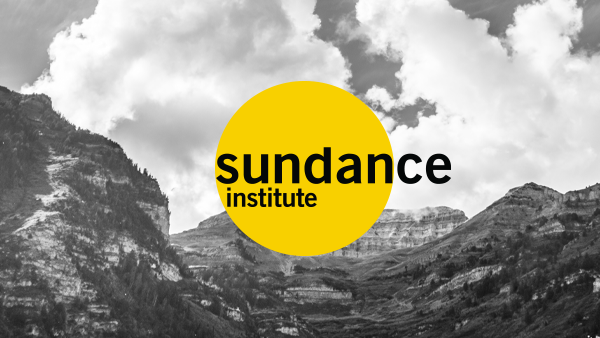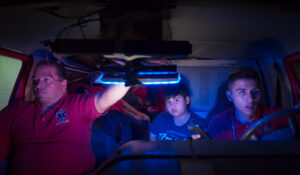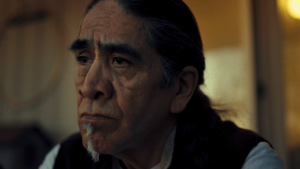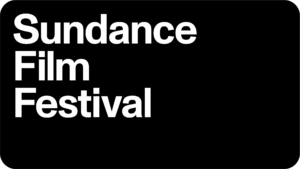Eric Hynes
It’s an aspect of filmmaking that gets very little attention, and that very few people in the film industry know how to talk about. So rather than shed just a little light on the subject, Sundance Film Festival and BMI positively flooded it. Ten directors and eleven composers crowded onto the stage at Sundance House Presented by HP on Wednesday afternoon for “Music and Film: The Creative Process,” a roundtable discussion on the process of scoring music for film.
Composers were paired with their collaborating directors (save for Kaboom’s Vivek Maddala, who rode solo without Gregg Araki), and all panelists had a film in this year’s Festival. As moderated by Doreen Ringer Ross, BMI’s vice president for Film/TV Relations, the discussion centered on the uncertain, but often fruitful, ground between two very different kinds of artists.
Music is often underscoring a scene, but it can also be the lead.
—Alex Wurman
“This relationship is the scariest part of making the movie,” said George Ratliff, director of Salvation Boulevard. Primary shooting is often completed, yet a defining aspect of the film still has to come together—largely outside of the director’s hands. Therefore it’s crucial to find the right match on both musical and personal grounds, and for both parties to take a (well-informed) leap of faith.
“A lot of the relationship is about trust,” said Harry Gregson-Williams, composer for Life in a Day. “It’s what’s so satisfying, but it also weighs heavily.”
All of the panelists talked of the difficulties of communication, since most directors don’t have a background in music and are literally at a loss for words when negotiating this crucial element of a film.
“This is, in a way, the most mystifying process,” said Matthew Chapman, director of The Ledge. “You’re trying to convey something across a lack of knowledge.”
Susan Saladoff, director of Hot Coffee, had a similar experience with her composer, Michael Mollura. “We didn’t have the same language,” she said. “I only knew what I liked and didn’t like.”
For Andrew Maclean, director of On the Ice, it was important not to devalue his role as a listener. “What I could do was talk from my perspective,” he said, “and from the perspective of a viewer.”
According to Chapman, the worst thing a director can do is to gloss over that divide. “If you pretend you know something you don’t, you’re in trouble,” he said. What got him through, and how he became enamored of the score for his film, was finding a composer with whom he could communicate on a human level.
In Nathan Barr, he found a composer that was comfortable enough to let him witness the music coming together. “He often sat behind me on the couch while I wrote and performed,” Barr said. “He understood his limitations, but he could talk in emotional terms, which I really appreciated.”
It also helps if a composer can talk in the language of film. “I could describe in non-musical, dramatic terms what I wanted to accomplish,” said George S. Clinton, an industry veteran who composed the music for Salvation Boulevard, and director Ratliff concurred that they “found a language at the very first meeting.”
Another tactic is to find a shared third language. Maryam Keshavarz, director of Circumstance, found it helpful to talk to her composer Gingger Shankar about old songs they both knew. “It’s like talking to a DP and referencing other films and scenes,” she said. “You’re speaking non-directly about what you like.”
As stressful as it can be for a director to entrust a film’s soundtrack with the personality and preferences of another person, it can be challenging for a composer to cede control not only to the director, but to explicitly serve and support the film. “My job is to give a director options,” said Mollura, and to be prepared to tweak even the most inspired work. “It’s all about making adjustments.”
iZLER, who composed the music for On the Ice, warned against becoming too attached to the music. “Be prepared to have your heart broken,” he said.
As for the difference between scoring documentaries vs. dramatic films, Peter Golub, composer of These Amazing Shadows and the director of the Sundance Institute Film Music Program, said there are no hard-and-fast rules. “It’s not like you do one thing for documentaries and another for fictions,” he said.
“There tends to be more talking in docs, and you’re not doing as much hitting” on emotional cues, “but it’s not true all of the time.” Yoav Potash, director of Crime After Crime, talked of the relationship between music and dialogue in documentaries in terms of complementary parts. “In musical terms, the people talking are the lead, the soloists,” said Potash. “If you’re using three instruments for a scene, think of the person talking as a fourth instrument.”Yet there’s a danger in letting the music become too recessed.
“Music is often underscoring a scene, but it can also be the lead,” said Alex Wurman, who composed the music for The Convincer, said. “If you hold back too much, you wind up with something flat.”
Furthermore, Clinton warned against becoming too passive in creating the right music for the film. “I actually think it’s necessary to defend your ideas,” he said, lest you lose sight of why you were the right man for the job.
And according to Barr, it’s also incumbent upon the director to make something that’s worthy of musical invention. “It’s hard to do something fresh if the source isn’t fresh,” he said, “if you’re seeing something you’ve seen before.”
In the end, and as with most things, the work turns out best when everyone feels inspired, supported, and protected. “I need to be encouraged,” said Wurman. “I don’t look like a flower, and I don’t feel like a flower. But if you treat me like a flower, I’ll make better music.”




